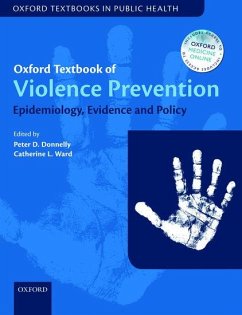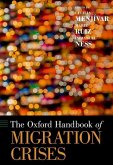Oxford Textbook of Violence Prevention
Epidemiology, Evidence, and Policy
Herausgegeben von Donnelly, Peter D.; Ward, Catherine L.
Oxford Textbook of Violence Prevention
Epidemiology, Evidence, and Policy
Herausgegeben von Donnelly, Peter D.; Ward, Catherine L.
- Gebundenes Buch
- Merkliste
- Auf die Merkliste
- Bewerten Bewerten
- Teilen
- Produkt teilen
- Produkterinnerung
- Produkterinnerung
Violence has always been, and is to this day, a primary cause of tension and suffering the world over. More than half a million people are murdered each year around the world, making homicide the leading cause of death among people aged 15-44. The Oxford Textbook of Violence Prevention brings together an international team of experts to provide an extensive global account of the mortality and morbidity burden caused by violence. It does this by examining the causes of violence, and what can be done to prevent and reduce violence.
Divided into six sections, the textbook analyses how a public…mehr
Andere Kunden interessierten sich auch für
![Oxford Handbook of Crime Prevention Oxford Handbook of Crime Prevention]() Brandon C WelshOxford Handbook of Crime Prevention234,99 €
Brandon C WelshOxford Handbook of Crime Prevention234,99 €![The Oxford Handbook of Sociology, Social Theory, and Organization Studies The Oxford Handbook of Sociology, Social Theory, and Organization Studies]() The Oxford Handbook of Sociology, Social Theory, and Organization Studies62,99 €
The Oxford Handbook of Sociology, Social Theory, and Organization Studies62,99 €![Oxford Encyclopedia of American Urban History Oxford Encyclopedia of American Urban History]() Oxford Encyclopedia of American Urban History494,99 €
Oxford Encyclopedia of American Urban History494,99 €![Oxford Handbook of Feminist Theory Oxford Handbook of Feminist Theory]() Oxford Handbook of Feminist Theory297,99 €
Oxford Handbook of Feminist Theory297,99 €![Africa in Contemporary Perspective. a Textbook for Undergraduate Students Africa in Contemporary Perspective. a Textbook for Undergraduate Students]() Africa in Contemporary Perspective. a Textbook for Undergraduate Students77,99 €
Africa in Contemporary Perspective. a Textbook for Undergraduate Students77,99 €![The Social Life of a Herstory Textbook The Social Life of a Herstory Textbook]() Massilia OurabahThe Social Life of a Herstory Textbook38,99 €
Massilia OurabahThe Social Life of a Herstory Textbook38,99 €![Oxford Handbook of Migration Crises Oxford Handbook of Migration Crises]() Oxford Handbook of Migration Crises251,99 €
Oxford Handbook of Migration Crises251,99 €-
-
-
Violence has always been, and is to this day, a primary cause of tension and suffering the world over. More than half a million people are murdered each year around the world, making homicide the leading cause of death among people aged 15-44. The Oxford Textbook of Violence Prevention brings together an international team of experts to provide an extensive global account of the mortality and morbidity burden caused by violence. It does this by examining the
causes of violence, and what can be done to prevent and reduce violence.
Divided into six sections, the textbook analyses how a public health approach can help to prevent violence. This multidisciplinary book tackles interpersonal violence in all its forms. Early chapters describe epidemiology and consequences, followed by chapters that present the current state of the evidence in interventions. Policies for violence reduction are discussed, and finally recommendations are made for researchers, practitioners, and policy-makers. The Oxford Textbook of Violence
Prevention is an essential resource for anyone involved in seeking to reduce the role of violence in modern society.
The print edition is complimented with 12 months free access to the online version. Featuring the full comprehensive and authoritative text of the book, the online edition has the added convenience and flexibility of an online resource and is available on oxfordmedicine.com.
Hinweis: Dieser Artikel kann nur an eine deutsche Lieferadresse ausgeliefert werden.
causes of violence, and what can be done to prevent and reduce violence.
Divided into six sections, the textbook analyses how a public health approach can help to prevent violence. This multidisciplinary book tackles interpersonal violence in all its forms. Early chapters describe epidemiology and consequences, followed by chapters that present the current state of the evidence in interventions. Policies for violence reduction are discussed, and finally recommendations are made for researchers, practitioners, and policy-makers. The Oxford Textbook of Violence
Prevention is an essential resource for anyone involved in seeking to reduce the role of violence in modern society.
The print edition is complimented with 12 months free access to the online version. Featuring the full comprehensive and authoritative text of the book, the online edition has the added convenience and flexibility of an online resource and is available on oxfordmedicine.com.
Hinweis: Dieser Artikel kann nur an eine deutsche Lieferadresse ausgeliefert werden.
Produktdetails
- Produktdetails
- Oxford Textbooks In Public Health
- Verlag: OUP Oxford / Oxford University Press
- Seitenzahl: 368
- Erscheinungstermin: 27. Januar 2015
- Englisch
- Abmessung: 282mm x 226mm x 20mm
- Gewicht: 140g
- ISBN-13: 9780199678723
- ISBN-10: 0199678723
- Artikelnr.: 41193202
- Herstellerkennzeichnung
- Libri GmbH
- Europaallee 1
- 36244 Bad Hersfeld
- gpsr@libri.de
- Oxford Textbooks In Public Health
- Verlag: OUP Oxford / Oxford University Press
- Seitenzahl: 368
- Erscheinungstermin: 27. Januar 2015
- Englisch
- Abmessung: 282mm x 226mm x 20mm
- Gewicht: 140g
- ISBN-13: 9780199678723
- ISBN-10: 0199678723
- Artikelnr.: 41193202
- Herstellerkennzeichnung
- Libri GmbH
- Europaallee 1
- 36244 Bad Hersfeld
- gpsr@libri.de
Peter Donnelly joined the University of St Andrews as Professor of Public Health Medicine in 2008. His research focuses on violence reduction and the evaluating gang member rehabilitation initiative in Glasgow, conducting pilot studies of technology aimed at reducing alcohol related violence, and exploring sports event related domestic abuse. Peter's other area of interest is in Health Systems; their organisation, funding, governance and accountability and how they can be optimised to maximise patient benefit and to reduce health inequalities. He chairs the steering group of the Scottish clinical leadership development program and is a member of the NHS Scotland leadership board. He is a member of the technical board of Milbank Memorial Fund and is on the steering group of the WHO Violence Prevention Alliance. From 2004 -2008 he was Deputy Chief Medical Officer to the Scottish Government. Peter has recently been appointed as President/Chief Executive Officer of Public Health Ontario. Catherine L. Ward is an Associate Professor in the Department of Psychology at the University of Cape Town, South Africa. She holds a PhD in Clinical-Community Psychology from the University of South Carolina, USA. Her research interests are in violence prevention from the perspective of children's development, and particularly in public health approaches to this. Cathy serves on the Steering Committee of the University of Cape Town's Safety and Violence Initiative, an interdisciplinary research initiative that seeks to understand violence and promote safety. The Safety and Violence Initiative is a member of the World Health Organization's Violence Prevention Alliance (VPA), and Cathy herself co-leads the VPA Parenting Project Group with Christopher Mikton from WHO and Theresa Kilbane from UNICEF. In addition, she is on the Editorial Boards for the South African Crime Quarterly, Psychosocial Interventions, and Child Abuse and Neglect journals.
* Section 1: An introduction to the study of violence as a public
health issue
* 1: Peter D. Donnelly and Catherine L. Ward: Interpersonal violence
and its importance as a global public health issue
* Section 2: The descriptive epidemiology of violence
* 2: Richard Matzopoulos, Kavi Bhalla, and James Harrison: Homicide
* 3: Melissa T. Merrick, Beverly L. Fortson, and James A. Mercy: The
epidemiology of child maltreatment
* 4: Catherine L. Ward: Youth violence
* 5: Richard E. Tremblay: Developmental origins of physical aggression
* 6: Heidi Stöckl, Karen Devries, and Charlotte Watts: The epidemiology
of intimate partner violence
* 7: Naeemah Abrahams, Karen Devries, Charlotte Watts, Christina
Pallitto, Max Petzold, Simukai Shamu, and Claudia Garcia-Moreno:
Prevalence of non-partner sexual violence: a review of global data
* 8: Francesco Mitis and Dinesh Sethi: Male on male violence
* 9: Bridget Penhale and Isabel Iborra: The epidemiology of elder abuse
* 10: Jorja Leap: Beyond convention: anthropology, drugs, and violence
* 11: Vania Ceccato: The geographic, socio-economic and cultural
determinants of violence
* Section 3: The consequences of violence
* 12: Megan Prinsloo, Debbie Bradshaw, and Ian Neethling: The
consequences of violence: assessing the health burden of violence
* 13: Sue Hawkridge, Astrid Berg, and Soraya Seedat: The consequences
of violence: mental health issues
* 14: Robin S. Engel and Jeffrey E. Clutter: Violence, police, and
criminal justice Systems
* 15: Phaedra Corso and Nathanial Taylor: The economic costs of
violence
* 16: Ross Deuchar: Violence and the education system
* Section 4: Evidence-informed programmes to reduce violence
* 17: Damien J. Williams, Anna J. Gavine, Catherine L. Ward, and Peter
D. Donnelly: What is evidence in violence prevention?
* 18: Jane Barlow: Preventing child maltreatment and youth violence
using parent training and home visiting programmes
* 19: Andrew Dawes: Violence prevention through reduction of risks to
child health and development in the years prior to school
* 20: Abigail A. Fagan and Richard F. Catalano: Preventing violence
through positive youth development programmes
* 21: Dorothy L. Espelage: Social-emotional school-based prevention
programmes and frameworks
* 22: Scott W. Henggeler: Preventing youth violence through therapeutic
interventions for high-risk youth
* 23: Christine Goodall: Preventing violence through interventions in
the health system
* 24: Stephen Smallbone and Nadine McKillop: Evidence-informed
approaches to preventing sexual violence and abuse
* 25: Lori Heise: Preventing intimate partner violence
* 26: Gene Feder and Lynnmarie Sardinha: Preventing intimate partner
violence through advocacy and support programmes
* 27: Michael Flood: Preventing male violence
* 28: Liesbeth de Donder: Evidence-informed programmes to reduce
violence: preventing elder abuse
* 29: Erika Gebo, Ellen Foley, and Laurie Ross: Preventing gang
violence
* 30: John M. Hagedorn: Chicago, I do mind dying
* 31: Christine Goodall: Preventing violence through interventions for
substance abuse
* 32: Jonathan Purtle, Theodore J. Corbin, Linda J. Rich, and John A.
Rich: Hospitals as a locus for violence intervention
* 33: Fergus G. Neville: Preventing violence through changing social
norms
* 34: Mohamed Seedat, Shahnaaz Suffla, and Catherine L. Ward:
Community-engaged violence prevention: approaches and principles
* Section 5: National and international policies to reduce violence
* 35: Robin J. Kimbrough-Melton and Gary B. Melton: Child protection
policy
* 36: Margaret Shaw: International, national and local government
policies to reduce youth violence
* 37: Heléne Combrinck: International policies to reduce and prevent
gender-based violence
* 38: Lillian Artz: National and international policies to reduce
domestic violence
* 39: Bridget Penhale: National and international policies to prevent
elder abuse
* 40: Guy Lamb: National and international policies to prevent and
reduce armed violence
* 41: Peter Anderson: Alcohol and violence
* 42: Mark A. R. Kleiman, Jonathan P. Caulkins, Tom Jacobson, and Brad
Rowe: Violence and drug control policy
* 43: Alison Morris Gehring and Peter D. Donnelly: How does policy
transfer support the uptake of violence prevention policy?
* 44: Alex Butchart and Chris Mikton: The history and role of
international agencies in violence prevention
* Section 6: Challenges and priorities for researchers, practitioners
and policy makers
* 45: Alex Butchart, Chris Mikton, Catherine L. Ward, and Peter D.
Donnelly: Challenges and priorities for practitioners and
policy-makers
* 46: Catherine L. Ward and Peter D. Donnelly: Challenges and
priorities for researchers
health issue
* 1: Peter D. Donnelly and Catherine L. Ward: Interpersonal violence
and its importance as a global public health issue
* Section 2: The descriptive epidemiology of violence
* 2: Richard Matzopoulos, Kavi Bhalla, and James Harrison: Homicide
* 3: Melissa T. Merrick, Beverly L. Fortson, and James A. Mercy: The
epidemiology of child maltreatment
* 4: Catherine L. Ward: Youth violence
* 5: Richard E. Tremblay: Developmental origins of physical aggression
* 6: Heidi Stöckl, Karen Devries, and Charlotte Watts: The epidemiology
of intimate partner violence
* 7: Naeemah Abrahams, Karen Devries, Charlotte Watts, Christina
Pallitto, Max Petzold, Simukai Shamu, and Claudia Garcia-Moreno:
Prevalence of non-partner sexual violence: a review of global data
* 8: Francesco Mitis and Dinesh Sethi: Male on male violence
* 9: Bridget Penhale and Isabel Iborra: The epidemiology of elder abuse
* 10: Jorja Leap: Beyond convention: anthropology, drugs, and violence
* 11: Vania Ceccato: The geographic, socio-economic and cultural
determinants of violence
* Section 3: The consequences of violence
* 12: Megan Prinsloo, Debbie Bradshaw, and Ian Neethling: The
consequences of violence: assessing the health burden of violence
* 13: Sue Hawkridge, Astrid Berg, and Soraya Seedat: The consequences
of violence: mental health issues
* 14: Robin S. Engel and Jeffrey E. Clutter: Violence, police, and
criminal justice Systems
* 15: Phaedra Corso and Nathanial Taylor: The economic costs of
violence
* 16: Ross Deuchar: Violence and the education system
* Section 4: Evidence-informed programmes to reduce violence
* 17: Damien J. Williams, Anna J. Gavine, Catherine L. Ward, and Peter
D. Donnelly: What is evidence in violence prevention?
* 18: Jane Barlow: Preventing child maltreatment and youth violence
using parent training and home visiting programmes
* 19: Andrew Dawes: Violence prevention through reduction of risks to
child health and development in the years prior to school
* 20: Abigail A. Fagan and Richard F. Catalano: Preventing violence
through positive youth development programmes
* 21: Dorothy L. Espelage: Social-emotional school-based prevention
programmes and frameworks
* 22: Scott W. Henggeler: Preventing youth violence through therapeutic
interventions for high-risk youth
* 23: Christine Goodall: Preventing violence through interventions in
the health system
* 24: Stephen Smallbone and Nadine McKillop: Evidence-informed
approaches to preventing sexual violence and abuse
* 25: Lori Heise: Preventing intimate partner violence
* 26: Gene Feder and Lynnmarie Sardinha: Preventing intimate partner
violence through advocacy and support programmes
* 27: Michael Flood: Preventing male violence
* 28: Liesbeth de Donder: Evidence-informed programmes to reduce
violence: preventing elder abuse
* 29: Erika Gebo, Ellen Foley, and Laurie Ross: Preventing gang
violence
* 30: John M. Hagedorn: Chicago, I do mind dying
* 31: Christine Goodall: Preventing violence through interventions for
substance abuse
* 32: Jonathan Purtle, Theodore J. Corbin, Linda J. Rich, and John A.
Rich: Hospitals as a locus for violence intervention
* 33: Fergus G. Neville: Preventing violence through changing social
norms
* 34: Mohamed Seedat, Shahnaaz Suffla, and Catherine L. Ward:
Community-engaged violence prevention: approaches and principles
* Section 5: National and international policies to reduce violence
* 35: Robin J. Kimbrough-Melton and Gary B. Melton: Child protection
policy
* 36: Margaret Shaw: International, national and local government
policies to reduce youth violence
* 37: Heléne Combrinck: International policies to reduce and prevent
gender-based violence
* 38: Lillian Artz: National and international policies to reduce
domestic violence
* 39: Bridget Penhale: National and international policies to prevent
elder abuse
* 40: Guy Lamb: National and international policies to prevent and
reduce armed violence
* 41: Peter Anderson: Alcohol and violence
* 42: Mark A. R. Kleiman, Jonathan P. Caulkins, Tom Jacobson, and Brad
Rowe: Violence and drug control policy
* 43: Alison Morris Gehring and Peter D. Donnelly: How does policy
transfer support the uptake of violence prevention policy?
* 44: Alex Butchart and Chris Mikton: The history and role of
international agencies in violence prevention
* Section 6: Challenges and priorities for researchers, practitioners
and policy makers
* 45: Alex Butchart, Chris Mikton, Catherine L. Ward, and Peter D.
Donnelly: Challenges and priorities for practitioners and
policy-makers
* 46: Catherine L. Ward and Peter D. Donnelly: Challenges and
priorities for researchers
* Section 1: An introduction to the study of violence as a public
health issue
* 1: Peter D. Donnelly and Catherine L. Ward: Interpersonal violence
and its importance as a global public health issue
* Section 2: The descriptive epidemiology of violence
* 2: Richard Matzopoulos, Kavi Bhalla, and James Harrison: Homicide
* 3: Melissa T. Merrick, Beverly L. Fortson, and James A. Mercy: The
epidemiology of child maltreatment
* 4: Catherine L. Ward: Youth violence
* 5: Richard E. Tremblay: Developmental origins of physical aggression
* 6: Heidi Stöckl, Karen Devries, and Charlotte Watts: The epidemiology
of intimate partner violence
* 7: Naeemah Abrahams, Karen Devries, Charlotte Watts, Christina
Pallitto, Max Petzold, Simukai Shamu, and Claudia Garcia-Moreno:
Prevalence of non-partner sexual violence: a review of global data
* 8: Francesco Mitis and Dinesh Sethi: Male on male violence
* 9: Bridget Penhale and Isabel Iborra: The epidemiology of elder abuse
* 10: Jorja Leap: Beyond convention: anthropology, drugs, and violence
* 11: Vania Ceccato: The geographic, socio-economic and cultural
determinants of violence
* Section 3: The consequences of violence
* 12: Megan Prinsloo, Debbie Bradshaw, and Ian Neethling: The
consequences of violence: assessing the health burden of violence
* 13: Sue Hawkridge, Astrid Berg, and Soraya Seedat: The consequences
of violence: mental health issues
* 14: Robin S. Engel and Jeffrey E. Clutter: Violence, police, and
criminal justice Systems
* 15: Phaedra Corso and Nathanial Taylor: The economic costs of
violence
* 16: Ross Deuchar: Violence and the education system
* Section 4: Evidence-informed programmes to reduce violence
* 17: Damien J. Williams, Anna J. Gavine, Catherine L. Ward, and Peter
D. Donnelly: What is evidence in violence prevention?
* 18: Jane Barlow: Preventing child maltreatment and youth violence
using parent training and home visiting programmes
* 19: Andrew Dawes: Violence prevention through reduction of risks to
child health and development in the years prior to school
* 20: Abigail A. Fagan and Richard F. Catalano: Preventing violence
through positive youth development programmes
* 21: Dorothy L. Espelage: Social-emotional school-based prevention
programmes and frameworks
* 22: Scott W. Henggeler: Preventing youth violence through therapeutic
interventions for high-risk youth
* 23: Christine Goodall: Preventing violence through interventions in
the health system
* 24: Stephen Smallbone and Nadine McKillop: Evidence-informed
approaches to preventing sexual violence and abuse
* 25: Lori Heise: Preventing intimate partner violence
* 26: Gene Feder and Lynnmarie Sardinha: Preventing intimate partner
violence through advocacy and support programmes
* 27: Michael Flood: Preventing male violence
* 28: Liesbeth de Donder: Evidence-informed programmes to reduce
violence: preventing elder abuse
* 29: Erika Gebo, Ellen Foley, and Laurie Ross: Preventing gang
violence
* 30: John M. Hagedorn: Chicago, I do mind dying
* 31: Christine Goodall: Preventing violence through interventions for
substance abuse
* 32: Jonathan Purtle, Theodore J. Corbin, Linda J. Rich, and John A.
Rich: Hospitals as a locus for violence intervention
* 33: Fergus G. Neville: Preventing violence through changing social
norms
* 34: Mohamed Seedat, Shahnaaz Suffla, and Catherine L. Ward:
Community-engaged violence prevention: approaches and principles
* Section 5: National and international policies to reduce violence
* 35: Robin J. Kimbrough-Melton and Gary B. Melton: Child protection
policy
* 36: Margaret Shaw: International, national and local government
policies to reduce youth violence
* 37: Heléne Combrinck: International policies to reduce and prevent
gender-based violence
* 38: Lillian Artz: National and international policies to reduce
domestic violence
* 39: Bridget Penhale: National and international policies to prevent
elder abuse
* 40: Guy Lamb: National and international policies to prevent and
reduce armed violence
* 41: Peter Anderson: Alcohol and violence
* 42: Mark A. R. Kleiman, Jonathan P. Caulkins, Tom Jacobson, and Brad
Rowe: Violence and drug control policy
* 43: Alison Morris Gehring and Peter D. Donnelly: How does policy
transfer support the uptake of violence prevention policy?
* 44: Alex Butchart and Chris Mikton: The history and role of
international agencies in violence prevention
* Section 6: Challenges and priorities for researchers, practitioners
and policy makers
* 45: Alex Butchart, Chris Mikton, Catherine L. Ward, and Peter D.
Donnelly: Challenges and priorities for practitioners and
policy-makers
* 46: Catherine L. Ward and Peter D. Donnelly: Challenges and
priorities for researchers
health issue
* 1: Peter D. Donnelly and Catherine L. Ward: Interpersonal violence
and its importance as a global public health issue
* Section 2: The descriptive epidemiology of violence
* 2: Richard Matzopoulos, Kavi Bhalla, and James Harrison: Homicide
* 3: Melissa T. Merrick, Beverly L. Fortson, and James A. Mercy: The
epidemiology of child maltreatment
* 4: Catherine L. Ward: Youth violence
* 5: Richard E. Tremblay: Developmental origins of physical aggression
* 6: Heidi Stöckl, Karen Devries, and Charlotte Watts: The epidemiology
of intimate partner violence
* 7: Naeemah Abrahams, Karen Devries, Charlotte Watts, Christina
Pallitto, Max Petzold, Simukai Shamu, and Claudia Garcia-Moreno:
Prevalence of non-partner sexual violence: a review of global data
* 8: Francesco Mitis and Dinesh Sethi: Male on male violence
* 9: Bridget Penhale and Isabel Iborra: The epidemiology of elder abuse
* 10: Jorja Leap: Beyond convention: anthropology, drugs, and violence
* 11: Vania Ceccato: The geographic, socio-economic and cultural
determinants of violence
* Section 3: The consequences of violence
* 12: Megan Prinsloo, Debbie Bradshaw, and Ian Neethling: The
consequences of violence: assessing the health burden of violence
* 13: Sue Hawkridge, Astrid Berg, and Soraya Seedat: The consequences
of violence: mental health issues
* 14: Robin S. Engel and Jeffrey E. Clutter: Violence, police, and
criminal justice Systems
* 15: Phaedra Corso and Nathanial Taylor: The economic costs of
violence
* 16: Ross Deuchar: Violence and the education system
* Section 4: Evidence-informed programmes to reduce violence
* 17: Damien J. Williams, Anna J. Gavine, Catherine L. Ward, and Peter
D. Donnelly: What is evidence in violence prevention?
* 18: Jane Barlow: Preventing child maltreatment and youth violence
using parent training and home visiting programmes
* 19: Andrew Dawes: Violence prevention through reduction of risks to
child health and development in the years prior to school
* 20: Abigail A. Fagan and Richard F. Catalano: Preventing violence
through positive youth development programmes
* 21: Dorothy L. Espelage: Social-emotional school-based prevention
programmes and frameworks
* 22: Scott W. Henggeler: Preventing youth violence through therapeutic
interventions for high-risk youth
* 23: Christine Goodall: Preventing violence through interventions in
the health system
* 24: Stephen Smallbone and Nadine McKillop: Evidence-informed
approaches to preventing sexual violence and abuse
* 25: Lori Heise: Preventing intimate partner violence
* 26: Gene Feder and Lynnmarie Sardinha: Preventing intimate partner
violence through advocacy and support programmes
* 27: Michael Flood: Preventing male violence
* 28: Liesbeth de Donder: Evidence-informed programmes to reduce
violence: preventing elder abuse
* 29: Erika Gebo, Ellen Foley, and Laurie Ross: Preventing gang
violence
* 30: John M. Hagedorn: Chicago, I do mind dying
* 31: Christine Goodall: Preventing violence through interventions for
substance abuse
* 32: Jonathan Purtle, Theodore J. Corbin, Linda J. Rich, and John A.
Rich: Hospitals as a locus for violence intervention
* 33: Fergus G. Neville: Preventing violence through changing social
norms
* 34: Mohamed Seedat, Shahnaaz Suffla, and Catherine L. Ward:
Community-engaged violence prevention: approaches and principles
* Section 5: National and international policies to reduce violence
* 35: Robin J. Kimbrough-Melton and Gary B. Melton: Child protection
policy
* 36: Margaret Shaw: International, national and local government
policies to reduce youth violence
* 37: Heléne Combrinck: International policies to reduce and prevent
gender-based violence
* 38: Lillian Artz: National and international policies to reduce
domestic violence
* 39: Bridget Penhale: National and international policies to prevent
elder abuse
* 40: Guy Lamb: National and international policies to prevent and
reduce armed violence
* 41: Peter Anderson: Alcohol and violence
* 42: Mark A. R. Kleiman, Jonathan P. Caulkins, Tom Jacobson, and Brad
Rowe: Violence and drug control policy
* 43: Alison Morris Gehring and Peter D. Donnelly: How does policy
transfer support the uptake of violence prevention policy?
* 44: Alex Butchart and Chris Mikton: The history and role of
international agencies in violence prevention
* Section 6: Challenges and priorities for researchers, practitioners
and policy makers
* 45: Alex Butchart, Chris Mikton, Catherine L. Ward, and Peter D.
Donnelly: Challenges and priorities for practitioners and
policy-makers
* 46: Catherine L. Ward and Peter D. Donnelly: Challenges and
priorities for researchers








